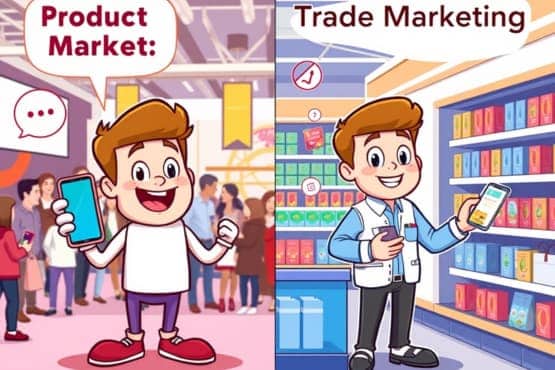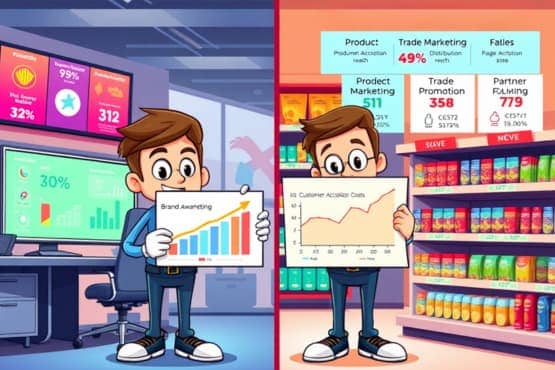In the world of marketing, understanding the difference between product marketing vs trade marketing is crucial for business success. These two distinct approaches uniquely move products from manufacturers to consumers.
When you walk into a supermarket and spot a new cereal brand with eye-catching packaging, you’re experiencing the results of both these strategies at work.
Product marketing vs trade marketing represents two sides of the same coin in the marketing world. While product marketing focuses on creating demand among end consumers, trade marketing concentrates on the supply chain and distribution channels.
Let’s explore how they differ, their roles throughout a product’s lifecycle, and how top companies leverage both in the business environment.
Key Takeaways
- Product marketing targets end consumers, while trade marketing focuses on intermediaries.
- Both strategies are crucial at different product lifecycle stages
- Successful companies integrate both approaches for a comprehensive strategy
- Digital tools and data analytics are reshaping both marketing disciplines
- Adapting to market changes and consumer behaviour is essential for success
What Are Product Marketing and Trade Marketing?
To better understand these two marketing approaches, let’s compare them side by side:

| Aspect | Product Marketing | Trade Marketing |
|---|---|---|
| Primary Focus | End consumers. | Intermediaries (retailers, distributors). |
| Key Objectives | Brand awareness, product adoption | Distribution expansion, shelf space optimization |
| Target Audience | Individual consumers | Retail partners, wholesalers |
| Key Strategies | Content marketing, social media engagement | In-store promotions, partner relationship management |
| Typical KPIs | Brand awareness, customer acquisition cost | Distribution reach, sell-through rates |
| Digital Tools | CRM systems, social media analytics | Trade promotion management software, retail execution platforms |
Product Marketing Explained
Product marketing creates demand among end consumers. It involves:
- Understanding customer needs
- Developing product positioning
- Creating messages that resonate with the target audience
Product marketers work closely with sales teams, giving them tools and knowledge to sell effectively. They focus on consumer engagement strategies to build brand loyalty and drive product adoption.
Trade Marketing Defined
Trade marketing focuses on the supply chain and distribution channels. It involves:
- Building relationships with retailers and wholesalers
- Ensuring products are available and visible where consumers shop
- Developing strategies to boost product visibility and sales within these channels
Trade marketers concentrate on channel marketing and retail partnerships to optimize product placement and promote and sell through various distribution channels.
According to a recent study by the Trade Marketing Association, companies that invest in robust trade marketing strategies see an average of 15% increase in distribution reach within the first year.
Goals: How They Align with Business Strategies
Product Marketing Aims
Product marketing primarily seeks to:
- Boost brand awareness
- Drive product adoption
- Support customer retention
- Gather and act on customer feedback
For example, when Samsung launches a new Galaxy smartphone, its product marketing team highlights new features and creates buzz to convince consumers to upgrade or switch from competitors.
They use consumer engagement tactics like influencer partnerships and interactive social media campaigns to generate excitement around the product launch.

Trade Marketing Objectives
Trade marketing aims to:
- Expand distribution channels
- Improve in-store product placement
- Increase sell-through rates
- Strengthen retail partner relationships
For instance, PepsiCo uses trade marketing to ensure its products are always in stock, prominently displayed, and part of promotional deals in stores worldwide.
A PepsiCo executive recently shared, “Our trade marketing efforts have led to a 20% increase in shelf space across major retailers, directly impacting our bottom line.” This success is largely due to their focus on category management and collaborative retail partnerships.
Target Audience: Who Are They Trying to Reach?
Product Marketing’s Consumer Focus
Product marketers create detailed buyer personas to understand their target consumers. They analyze:
- Consumer behavior
- Preferences
- Pain points
This research helps craft messages that resonate with different customer groups. For instance, Apple’s product marketing for the iPhone varies significantly between younger, tech-savvy consumers and older users, prioritizing ease of use.

Trade Marketing’s Partner Focus
Trade marketers focus on the needs of channel partners. They work to understand:
- Business goals of retailers and distributors
- How to create programs that align with these objectives
This often involves developing custom promotions, providing sales support, and offering financial incentives. Unilever, for example, offers its retail partners customized category management insights, helping them optimize their entire product category, not just Unilever products.
Strategies: From Awareness to Sales
Product Marketing Tactics
Common product marketing strategies include:
- Clear product positioning
- Compelling brand stories
- Content marketing campaigns
- Social media engagement
- Product demos and trials
For example, Nike’s product marketing often focuses on inspiring athletes and fitness enthusiasts, showcasing how their products enhance performance and style.
Their “Just Do It” campaign is a prime example of effective product marketing that resonates across various consumer segments.

Trade Marketing Approaches
Trade marketing often uses tactics such as:
- Negotiating prime shelf space
- Offering volume discounts to retailers
- Creating in-store displays
- Training retail staff
- Participating in trade shows
Procter & Gamble, for instance, is known for its strong trade marketing and innovative marketing takes. They work closely with retailers to optimize product placement and develop joint promotional campaigns for various consumer goods brands. P&G’s “store within a store” concept for beauty products has increased sales by up to 30% in participating retailers.
Product Lifecycle: Adapting to Market Changes
Both product and trade marketing strategies evolve throughout a product’s lifecycle stages: introduction, growth, maturity, and decline. Let’s examine how these strategies differ in the tech industry versus fast-moving consumer goods (FMCG).
Introduction Stage
- Product marketing: Creates awareness and educates consumers about the new product
- Trade marketing: Secures initial distribution and prominent store placement
When Impossible Foods introduced its plant-based meat, it focused on educating end consumers about the taste and environmental benefits through digital marketing. Their trade marketing team worked to get the product into grocery stores and restaurant chains.
In contrast, when Sony launched the PlayStation 5, their product marketing emphasized the console’s advanced features, while trade marketing focused on managing pre-orders and allocating limited stock to retailers.
Growth Stage
- Product marketing: Shifts to differentiation and building brand preference
- Trade marketing: Expands distribution and increases market share
During its growth phase, Spotify’s product marketing emphasized its personalized playlists and vast music library. Their trade marketing focused on partnering with device manufacturers and telecom companies to expand their reach.
When Oatly expanded its oat milk product line in the FMCG sector, it used influencer partnerships for product marketing. In contrast, its trade marketing efforts focused on securing prominent grocery store refrigerator space.

Maturity Stage
- Product marketing: Often involves refreshing the brand image and finding new product uses
- Trade marketing: Focuses on maintaining shelf space and defending against competitors
Coca-Cola has successfully navigated the maturity stage by introducing new flavors and packaging sizes. Their trade marketing ensures these new products receive prime placement in stores.
In tech, Microsoft’s mature Office suite is marketed with a focus on new features and cloud integration, while trade marketing efforts emphasize volume licensing deals with businesses and educational institutions.
Decline Stage
- Product marketing: May target niche segments still interested in the product
- Trade marketing: Might focus on liquidation strategies or repositioning in different channels.
As digital cameras gained popularity, Fujifilm shifted its product marketing for film cameras to target professional photographers and enthusiasts. Their trade marketing focused on maintaining a presence in specialty camera stores.
In FMCG, as consumers shifted away from sugary cereals, Kellogg’s adapted by marketing their classic brands as nostalgic treats while introducing healthier options, showcasing effective product management. Their trade marketing pivoted to secure better placement in the health food aisles.
Which Strategy Is Right for Your Business
Choosing between focusing on product marketing or trade marketing depends on various factors. Here’s a guide to help you decide:

- Product Type:
- Complex or innovative products often require more product marketing to educate consumers.
- Commoditized products may benefit more from strong trade marketing to stand out at the point of sale.
- Distribution Model:
- Direct-to-consumer brands should prioritize product marketing.
- Businesses relying heavily on retailers need robust trade marketing.
- Market Position:
- New entrants might focus on product marketing to build brand awareness.
- Established brands could benefit from trade marketing to maintain market share.
- Budget Constraints:
- Limited budgets might favor focused product marketing campaigns.
- Larger budgets allow for comprehensive strategies covering both areas.
- Industry Dynamics:
- In fast-moving tech industries, product marketing often takes precedence.
- Trade marketing might be more critical in FMCG, where shelf space is crucial.
Remember, the most successful businesses often find a balance between both strategies, adapting their approach as market conditions change.
Measuring Success: Key Performance Indicators
Product Marketing Metrics
Key performance indicators (KPIs) for product marketing often include:
- Brand awareness levels
- Customer acquisition costs
- Effective market research and marketing strategies influence product adoption rates.
- Customer lifetime value
- Net Promoter Score (NPS)
According to a recent McKinsey report, companies that excel in product marketing see a 20% higher customer lifetime value than their industry peers.

Trade Marketing Metrics
Trade marketing success is typically measured by:
- Distribution reach and depth
- Sell-through rates
- Share of shelf space
- Trade promotion ROI
- Partner satisfaction scores
A Nielsen study found that effective trade marketing can increase sell-through rates by up to 25% for new product launches.
Digital Transformation
E-commerce has blurred the lines between product and trade marketing, creating new challenges and opportunities.
Digital Tools for Product Marketing
Product marketers now use:
- Customer Relationship Management (CRM) systems
- Social media analytics platforms
- Content management systems
- Marketing automation software is essential for trade marketing managers to streamline their processes.
Amazon, for instance, uses data analytics to personalize product recommendations, effectively marketing its vast product range through tailored user experiences. According to company reports, their recommendation engine accounts for 35% of their total sales.

Digital Tools for Trade Marketing
Trade marketers are adopting:
- Trade promotion management software
- Retail execution platforms
- Digital asset management systems
- Partner relationship management tools
Walmart’s Supplier Center is an example of how digital tools transform trade marketing. It provides suppliers with real-time data on sales and inventory to optimize their strategies. Suppliers using this platform have reported up to 40% improvement in stock availability.
Case Studies: Success Stories
Product Marketing Win: Airbnb
Airbnb disrupted the hospitality industry with its peer-to-peer lodging platform, utilizing digital marketing to reach consumers. Its product marketing strategy showcases unique travel experiences and local authenticity. This approach helped the company grow rapidly, with over 4 million hosts worldwide as of 2021.

Key to their success was user-generated content and storytelling. By encouraging hosts and guests to share their experiences, Airbnb created a powerful word-of-mouth marketing engine. Their “Live There” campaign, which emphasized authentic local experiences, led to a 14% increase in bookings in its first year.
Trade Marketing Triumph: Procter & Gamble
P&G’s trade marketing strategy goes beyond traditional retail channels. The company created the ” store-within-a-store ” concept for its beauty products, providing specialized training to retail staff and creating branded displays. This approach has helped P&G maintain strong relationships with retailers and increase sales across its product lines.

One specific initiative, the “Beauty Aisle Reinvention” program, led to a 17% increase in category sales for participating retailers. P&G’s trade marketing director noted, “By helping our retail partners succeed, we’ve been able to grow our market share consistently across multiple product categories.”
Emerging Trends: The Future of Marketing
Both product and trade marketing are being shaped by:
- AI-driven personalization
- Augmented reality for product visualization
- Sustainability-focused messaging
- Omnichannel experiences
- Influencer partnerships

Companies like L’Oréal are at the forefront of these trends, using AI for personalized skincare recommendations and AR for virtual makeup try-ons. Their “Makeup Genius” app, which allows users to try on makeup products virtually, has been downloaded over 20 million times and has significantly boosted online sales.
Challenges: Navigating the Marketing Landscape
Product Marketing Hurdles
- Keeping pace with changing consumer preferences
- Standing out in saturated markets
- Balancing short-term sales with long-term brand building
A survey by the Product Marketing Alliance found that 68% of product marketers struggle to measure the direct impact of their efforts on sales, highlighting the need for better attribution models.

Trade Marketing Obstacles
- Managing complex partner relationships
- Optimizing Trade spend in a promotional retail Environment
- Adapting to the growth of e-commerce through digital marketing strategies.
The Trade Marketing Association reports that 55% of trade marketers find it challenging to justify their budgets to senior management, emphasizing the need for clearer ROI metrics.
Conclusion: Integrating for Success
Successful companies recognize the importance of integrating product and trade marketing approaches. By aligning product development, consumer messaging, and channel strategies, businesses create a seamless path from production to purchase.
Product and trade marketing lines are increasingly blurred in the omnichannel world. Combining consumer-focused strategies with solid channel partnerships, an integrated approach is key to standing out in a crowded marketplace and driving sustainable growth.
By carefully balancing these strategies and staying attuned to market trends, businesses can create more effective, holistic marketing approaches that drive growth and build lasting customer relationships.




